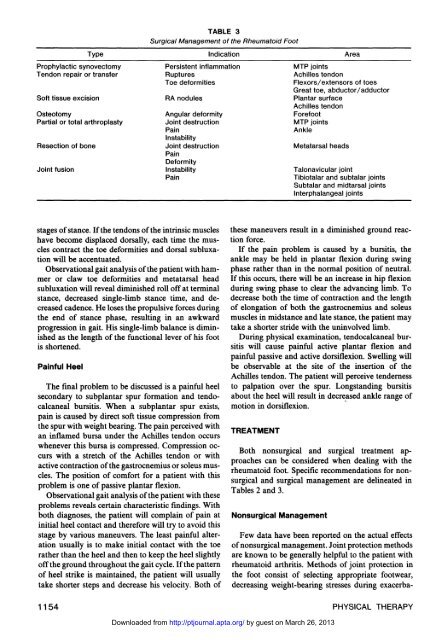Pathomechanics, Gait Deviations, and Treatment ... - Physical Therapy
Pathomechanics, Gait Deviations, and Treatment ... - Physical Therapy
Pathomechanics, Gait Deviations, and Treatment ... - Physical Therapy
Create successful ePaper yourself
Turn your PDF publications into a flip-book with our unique Google optimized e-Paper software.
Type<br />
Prophylactic synovectomy<br />
Tendon repair or transfer<br />
Soft tissue excision<br />
Osteotomy<br />
Partial or total arthroplasty<br />
Resection of bone<br />
Joint fusion<br />
TABLE 3<br />
Surgical Management of the Rheumatoid Foot<br />
Indication<br />
Persistent inflammation<br />
Ruptures<br />
Toe deformities<br />
RA nodules<br />
Angular deformity<br />
Joint destruction<br />
Pain<br />
Instability<br />
Joint destruction<br />
Pain<br />
Deformity<br />
Instability<br />
Pain<br />
stages of stance. If the tendons of the intrinsic muscles<br />
have become displaced dorsally, each time the muscles<br />
contract the toe deformities <strong>and</strong> dorsal subluxation<br />
will be accentuated.<br />
Observational gait analysis of the patient with hammer<br />
or claw toe deformities <strong>and</strong> metatarsal head<br />
subluxation will reveal diminished roll off at terminal<br />
stance, decreased single-limb stance time, <strong>and</strong> decreased<br />
cadence. He loses the propulsive forces during<br />
the end of stance phase, resulting in an awkward<br />
progression in gait. His single-limb balance is diminished<br />
as the length of the functional lever of his foot<br />
is shortened.<br />
Painful Heel<br />
The final problem to be discussed is a painful heel<br />
secondary to subplantar spur formation <strong>and</strong> tendocalcaneal<br />
bursitis. When a subplantar spur exists,<br />
pain is caused by direct soft tissue compression from<br />
the spur with weight bearing. The pain perceived with<br />
an inflamed bursa under the Achilles tendon occurs<br />
whenever this bursa is compressed. Compression occurs<br />
with a stretch of the Achilles tendon or with<br />
active contraction of the gastrocnemius or soleus muscles.<br />
The position of comfort for a patient with this<br />
problem is one of passive plantar flexion.<br />
Observational gait analysis of the patient with these<br />
problems reveals certain characteristic findings. With<br />
both diagnoses, the patient will complain of pain at<br />
initial heel contact <strong>and</strong> therefore will try to avoid this<br />
stage by various maneuvers. The least painful alteration<br />
usually is to make initial contact with the toe<br />
rather than the heel <strong>and</strong> then to keep the heel slightly<br />
off the ground throughout the gait cycle. If the pattern<br />
of heel strike is maintained, the patient will usually<br />
take shorter steps <strong>and</strong> decrease his velocity. Both of<br />
Area<br />
MTP joints<br />
Achilles tendon<br />
Flexors/extensors of toes<br />
Great toe, abductor/adductor<br />
Plantar surface<br />
Achilles tendon<br />
Forefoot<br />
MTP joints<br />
Ankle<br />
Metatarsal heads<br />
Talonavicular joint<br />
Tibiotalar <strong>and</strong> subtalar joints<br />
Subtalar <strong>and</strong> midtarsal joints<br />
Interphalangeal joints<br />
these maneuvers result in a diminished ground reaction<br />
force.<br />
If the pain problem is caused by a bursitis, the<br />
ankle may be held in plantar flexion during swing<br />
phase rather than in the normal position of neutral.<br />
If this occurs, there will be an increase in hip flexion<br />
during swing phase to clear the advancing limb. To<br />
decrease both the time of contraction <strong>and</strong> the length<br />
of elongation of both the gastrocnemius <strong>and</strong> soleus<br />
muscles in midstance <strong>and</strong> late stance, the patient may<br />
take a shorter stride with the uninvolved limb.<br />
During physical examination, tendocalcaneal bursitis<br />
will cause painful active plantar flexion <strong>and</strong><br />
painful passive <strong>and</strong> active dorsiflexion. Swelling will<br />
be observable at the site of the insertion of the<br />
Achilles tendon. The patient will perceive tenderness<br />
to palpation over the spur. Longst<strong>and</strong>ing bursitis<br />
about the heel will result in decreased ankle range of<br />
motion in dorsiflexion.<br />
TREATMENT<br />
Both nonsurgical <strong>and</strong> surgical treatment approaches<br />
can be considered when dealing with the<br />
rheumatoid foot. Specific recommendations for nonsurgical<br />
<strong>and</strong> surgical management are delineated in<br />
Tables 2 <strong>and</strong> 3.<br />
Nonsurgical Management<br />
Few data have been reported on the actual effects<br />
of nonsurgical management. Joint protection methods<br />
are known to be generally helpful to the patient with<br />
rheumatoid arthritis. Methods of joint protection in<br />
the foot consist of selecting appropriate footwear,<br />
decreasing weight-bearing stresses during exacerba-<br />
1154 PHYSICAL THERAPY<br />
Downloaded from<br />
http://ptjournal.apta.org/ by guest on March 26, 2013
















